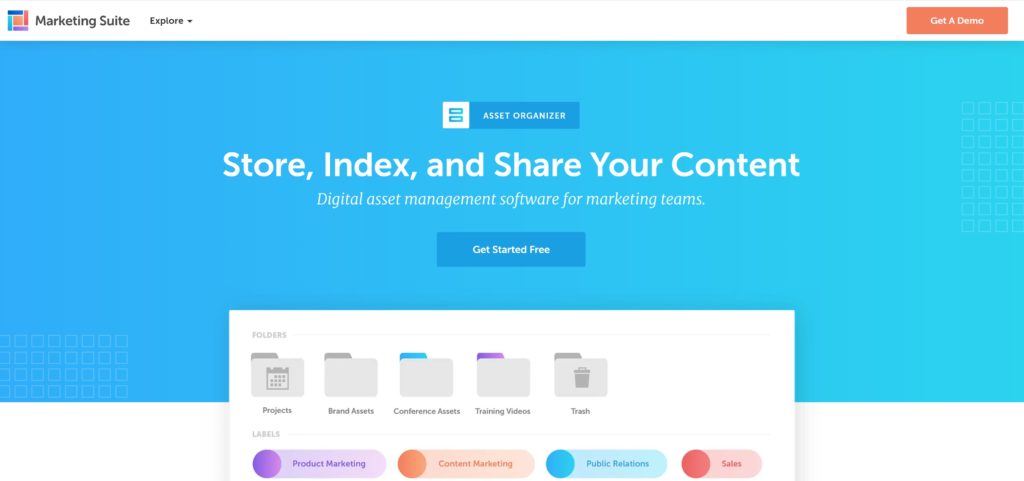Creating a content production system means empowering your team members (or future team members) to assemble and deliver content without your involvement. For many small business owners, this can be a scary thought. After all, you know your business best, right?
But if you want to scale your business, you need to scale your output. And this means delegating and enabling others to contribute to your content marketing strategy. Fortunately, creating a content production process is relatively simple – you just need to put the right infrastructure and protocols in place.
This article will help you create a system and assemble a content team in just eight steps. No matter your approach to marketing, this simple process will ensure that your business produces more high-quality content than ever before!
What Is Content Production?
Content production is the process of developing creative assets for your business. These assets can be used for a variety of marketing initiatives, including social media, email marketing, website development, and more.
The goal of content production is to create high-quality content that will engage your audience and elevate your brand. In order to do this, you need to have a clear understanding of your audience and what they want to see or learn from your business. Once you deeply understand your target demographic, you can begin developing a content strategy that will engage them and fill their needs.
Types Of Content
The most effective content strategies include a mix of different types of content. To increase your reach, influence, and engagement, consider producing a few of the following content types:
Forms
- Print: Books, Newspaper articles, White papers, Press releases
- Digital: Blog posts, Ebooks, Emails, Social media imagery, Infographics
- Video: Long-form (YouTube, Webinars), Short-form (TikTok, Instagram Reels)
Moods
- Entertaining: Captures the attention of the audience with a new idea
- Educational: Builds the audience’s knowledge in a specific area relevant to your business
- Interactive: Engages the audience and elicits a response
Website Content

- Cornerstone: The most comprehensive and in-depth type of content. Serves as a foundation for other pieces of content.
- Gated: Content used a lead capture or monetization tool. In order to access the content, the audience must provide their contact information or subscribe.
- Evolving: Topical content that changes over time. Can be updated with new information, statistics, data, and more.
How To Scale Your Content Production Process
1) Establish Goals
Before creating any content, take a moment to establish your content marketing goals. Do you hope to attract potential customers with SEO lead generation, position yourself as a niche authority, or build an audience on a social media platform?
Then, turn these objectives into north star metrics that you can use to track your progress. These metrics should be specific, measurable, attainable, relevant, and time-bound (SMART). For example, you could shoot for 10,000 organic monthly visitors by the end of Q3 or 100,000 followers on Instagram by the end of the year.
2) Decide on Content Strategy
With your SMART goals in mind, decide on the types of content and the volume you need to produce. Look at other businesses that have achieved your desired outcome (with tools like the Facebook Ad Library) and analyze their content mix. How often are they releasing new content? What topics are they covering? What formats are they using?
Your answers to these questions will help you develop an initial content production strategy. Over time, you can experiment with other forms of content and release frequencies to find what your audience responds to.
If you aim to drive organic traffic, start by writing informative blog posts. But use competitors to guide your keyword research, depth of coverage, and publishing cadence. If they dabble in social media platforms like Twitter and Facebook, perhaps they are worth your while as well.
And if your objective is to build an audience on social media, determine where your target demographic spends time. For example, if your ideal customer is a Gen-Z female, TikTok and Instagram should be your go-to platforms. In this case, use both apps to cross-promote your short-form videos with your lifestyle images.
3) Create An Organization System
While the content creation process will vary based on content type, every business should have a standard collaboration, storage, and retrieval infrastructure. A logical organization system will enable your team to perform their jobs effectively and find the information, inputs, and assets they need.
Before creating content, consider having some collaborative forum for ideation. This could be the initial phase of your step-by-step process or a periodic meeting to discuss new content ideas. These content topics should then be added to, and potentially ranked or sorted, in a master idea list. This document, as well as each piece of content, should adhere to a standard naming convention and be stored within an organized folder structure.
These rules will help inform content team members on how to share ideas, locate files, upload content, and contribute to the broader content production system.
4) List Individual Tasks
With the content strategy and infrastructure in place, it is time to think through each individual task in the content creation process. For each type of content, consider the workflow necessary to bring it to life.
For a blog post, this could include performing keyword research, drafting a creative brief, writing a draft, adding high-quality images, editing, uploading, and social media promotion. For a YouTube video, the process might involve storyboarding, filming, video editing, sound mixing, thumbnail creation, and caption writing.
It is important to be thorough in this step because anything that is not explicitly listed will create gaps and confusion in the workflow. To avoid missed steps and blown deadlines, continue to revisit this stage as your content strategy and team evolve.
5) Form A Team

After listing all necessary tasks, begin grouping them according to skillset with team size in mind. For example, a team of three will require cross-functional roles, where the content writer might also lead SEO and copywriting. A team of 15, on the other hand, will allow for more specialized positions.
Once you have divvied up tasks and created roles, either assign these to your current team members or begin the hiring process. With clear expectations for your employees, you are able to give real agency to each team member. This prevents any diffusion of responsibility and enables you to hold them accountable for results.
Fortunately, this type of environment attracts the best talent to your team. Those who seek to skirt responsibility and avoid ownership will quickly move on to an organization with a more lax culture. And those who are passionate and excited to see their real-world impact will enjoy working in a performance-based workplace.
6) Set Standard Timelines
The next step in setting up a content production process is to establish timelines for each task, role, and type of content. These timelines should be specific and attainable, based on the average time it takes to complete each task and the team’s current bandwidth.
As you set these due dates, be sure to consider any external deadlines that might apply. For example, if you are launching a new product, you will want to ensure that all marketing materials are ready well in advance.
If possible, add a buffer to each timeline in case of delays or unforeseen obstacles. This will help you avoid last-minute rushes and prevent content quality from suffering. With these due dates in mind, use a calendar or planner to visually track each piece of content.
To keep everyone on track, establish a system for regular check-ins and feedback. This could be a daily stand-up, a Slack channel dedicated to content production, or automated deadline notifications. These firm timelines will help keep team members accountable, productive, and aware of who is working on what.
7) Allow for Content Review
Before publishing any content, it is critical to allow time for a final review. This quality control step helps to catch any errors that may have been missed along the way- and to spot inconsistencies. With a task-oriented system, this holistic review ensures that the content meets the standards of your business. You will be able to rest assured that at least one critical eye has reviewed the content before it becomes publicly available.
If your team size allows, you could even set up a review process that allows for feedback from multiple team members. This could take the form of a traditional proofreading model, or simply as an open forum for comments, questions, and suggestions.
8) Track Results
With so much effort put forth into creating and maintaining an effective content production process, you would think that tracking results is a natural next step. Unfortunately, this is not always the case. Many businesses become so consumed with content creation and adhering to strict content calendars, that they forget to review their progress along the way. Don’t fall victim to this trap.
Continually track your metrics and post them somewhere visible for the team. This will help to keep everyone focused on the ultimate goal – not simply publishing content but driving the business forward.
Further, use analytics tools to surface insights into what is working and where there is room for improvement. For example, are your click rates high but retention rates low? You may have great titles and imagery, but need to beef up the content quality. And if you find that your social media following is increasing but website traffic is stagnant, you may need to incorporate more brand mentions and calls to action.
Content production is an iterative process, so be sure to review your results regularly and course-correct where necessary. Only then will you be able to ensure that your content is truly helping you reach your goals.
Tools for Content Production & Content Marketing
Asset Management

As your content production process kicks into gear, you will need somewhere to store and organize the growing repository of creative assets! For small businesses, the 30GB of storage per G Suite user is often enough.
If you find yourself outgrowing Google Drive, however, CoSchedule’s Asset Organizer offers a streamlined content library, with handy features for cataloging and version tracking.
Content Calendar
To create and manage your content calendar for free, consider using this social media Excel template courtesy of HubSpot. This calendar is easy to modify, helps you organize campaigns, and allows you to visualize your content posting cadence.
For a more dynamic and multi-user solution, try Loomly. This all-in-one content planning and publishing tool features list and calendar views, analytics, and a collaborative environment. Marketing teams can request content approval, post directly to social media, and even respond directly to comments from the platform.
Project Management
If your content team grows beyond two or three people, managing the content workflow can become a challenge. To simplify the handoff and notification processes, project management software like Trello, Asana, and ClickUp can help.
These workflow tools also allow you to create Kanban boards, assign tasks, attach files, leave comments, and track deadlines in one place. Plus, with conditional automations you can trigger certain actions when team members submit work, near a deadline, or leave a comment.
Image Creation
Whether you are creating a blog post, a YouTube thumbnail, or an infographic, attention-grabbing visuals are an important part of the content production process. To get started, check out the huge library of design tools that Canva offers for free. Upgrade to a paid version for access to even more images and resources, or test Visme for more complicated design templates.
Communication

For small teams, email and project management software is often sufficient for communication. But as companies grow, managing tasks and ongoing conversations across different channels can become overwhelming.
If email is no longer cutting it, supercharge your internal communication with Slack. The collaboration platform offers video conferencing, direct messaging, and app integrations to help you get work done faster. Slack offers both free and paid plans depending on your team’s needs.
Final Thoughts
Efficient content production is a crucial function in every business that wants to grow. From social media marketing to search engine optimization and lead generation, a well-oiled content machine and an understanding of marketing models can power your entire content marketing strategy.
By following the eight steps in this guide, you can streamline your content workflow, save time, and produce higher-quality content. Plus, with the right tools in place, you can automate many of the most tedious tasks so that you and your team can focus on creating great content.



